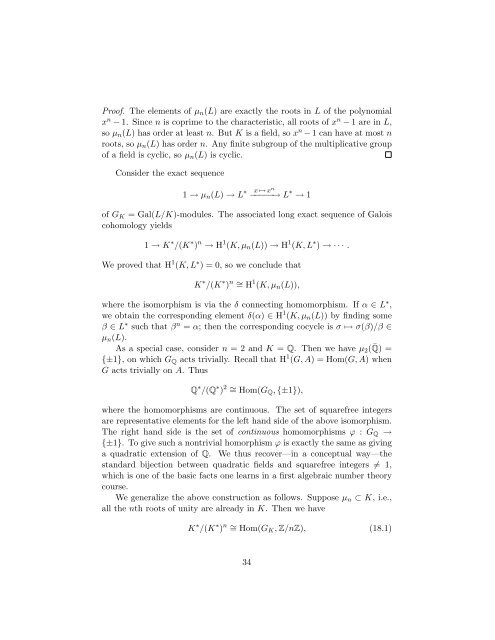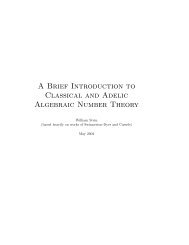A Short Course on Galois Cohomology - William Stein - University of ...
A Short Course on Galois Cohomology - William Stein - University of ...
A Short Course on Galois Cohomology - William Stein - University of ...
Create successful ePaper yourself
Turn your PDF publications into a flip-book with our unique Google optimized e-Paper software.
Pro<strong>of</strong>. The elements <strong>of</strong> µn(L) are exactly the roots in L <strong>of</strong> the polynomial<br />
x n − 1. Since n is coprime to the characteristic, all roots <strong>of</strong> x n − 1 are in L,<br />
so µn(L) has order at least n. But K is a field, so x n − 1 can have at most n<br />
roots, so µn(L) has order n. Any finite subgroup <strong>of</strong> the multiplicative group<br />
<strong>of</strong> a field is cyclic, so µn(L) is cyclic.<br />
C<strong>on</strong>sider the exact sequence<br />
1 → µn(L) → L ∗ x ↦→ x n<br />
−−−−−→ L ∗ → 1<br />
<strong>of</strong> GK = Gal(L/K)-modules. The associated l<strong>on</strong>g exact sequence <strong>of</strong> <strong>Galois</strong><br />
cohomology yields<br />
1 → K ∗ /(K ∗ ) n → H 1 (K, µn(L)) → H 1 (K, L ∗ ) → · · · .<br />
We proved that H 1 (K, L ∗ ) = 0, so we c<strong>on</strong>clude that<br />
K ∗ /(K ∗ ) n ∼ = H 1 (K, µn(L)),<br />
where the isomorphism is via the δ c<strong>on</strong>necting homomorphism. If α ∈ L ∗ ,<br />
we obtain the corresp<strong>on</strong>ding element δ(α) ∈ H 1 (K, µn(L)) by finding some<br />
β ∈ L ∗ such that β n = α; then the corresp<strong>on</strong>ding cocycle is σ ↦→ σ(β)/β ∈<br />
µn(L).<br />
As a special case, c<strong>on</strong>sider n = 2 and K = Q. Then we have µ2( ¯ Q) =<br />
{±1}, <strong>on</strong> which GQ acts trivially. Recall that H 1 (G, A) = Hom(G, A) when<br />
G acts trivially <strong>on</strong> A. Thus<br />
Q ∗ /(Q ∗ ) 2 ∼ = Hom(GQ, {±1}),<br />
where the homomorphisms are c<strong>on</strong>tinuous. The set <strong>of</strong> squarefree integers<br />
are representative elements for the left hand side <strong>of</strong> the above isomorphism.<br />
The right hand side is the set <strong>of</strong> c<strong>on</strong>tinuous homomorphisms ϕ : GQ →<br />
{±1}. To give such a n<strong>on</strong>trivial homorphism ϕ is exactly the same as giving<br />
a quadratic extensi<strong>on</strong> <strong>of</strong> Q. We thus recover—in a c<strong>on</strong>ceptual way—the<br />
standard bijecti<strong>on</strong> between quadratic fields and squarefree integers = 1,<br />
which is <strong>on</strong>e <strong>of</strong> the basic facts <strong>on</strong>e learns in a first algebraic number theory<br />
course.<br />
We generalize the above c<strong>on</strong>structi<strong>on</strong> as follows. Suppose µn ⊂ K, i.e.,<br />
all the nth roots <strong>of</strong> unity are already in K. Then we have<br />
K ∗ /(K ∗ ) n ∼ = Hom(GK, Z/nZ), (18.1)<br />
34
















